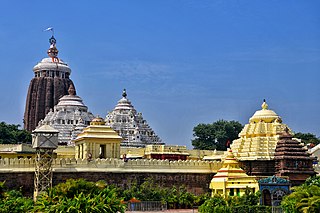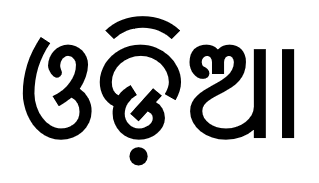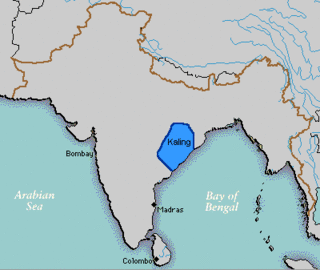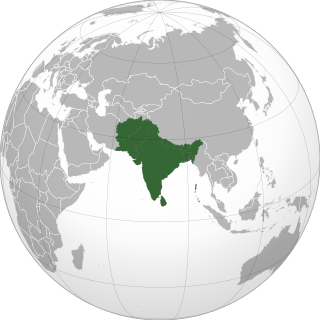Related Research Articles

Odisha, formerly Orissa, is a state located in Eastern India. It is the eighth-largest state by area, and the eleventh-largest by population, with over 41 million inhabitants. The state also has the third-largest population of Scheduled Tribes in India. It neighbours the states of Jharkhand and West Bengal to the north, Chhattisgarh to the west, and Andhra Pradesh to the south. Odisha has a coastline of 485 kilometres (301 mi) along the Bay of Bengal in the Indian Ocean. The region is also known as Utkaḷa and is mentioned by this name in India's national anthem, Jana Gana Mana. The language of Odisha is Odia, which is one of the Classical languages of India.

Odia is a classical Indo-Aryan language spoken in the Indian state of Odisha. It is the official language in Odisha, where native speakers make up 82% of the population, and it is also spoken in parts of West Bengal, Jharkhand, Andhra Pradesh and Chhattisgarh. Odia is one of the official languages of India; it is the official language of Odisha and the second official language of Jharkhand. The Odia language has various dialects varieties, including the Baleswari Odia, Kataki, Ganjami Odia, Sundargadi Odia, Sambalpuri, Desia and Tribal Community dialects who spoken by the tribals groups in Odisha who adopted the Odia language.

Kalinga is a historical region of India. It is generally defined as the eastern coastal region between the Ganges and the Godavari rivers, although its boundaries have fluctuated with the territory of its rulers. The core territory of Kalinga now encompasses all of Odisha and some part of northern Andhra Pradesh. At its widest extent, the Kalinga region also included parts of present-day Chhattisgarh, extending up to Amarkantak in the west. In the ancient period it extended until the bank of the Ganges river.

Vaṅga was an ancient kingdom and geopolitical division within the Ganges delta in the Indian subcontinent. The kingdom is one of the namesakes of the Bengal region. It was located in eastern and southern Bengal. Vanga features prominently in the epics and tales of ancient India as well as in the history of Sri Lanka.

Boudh District is an administrative and municipal district, one of thirty in the Odisha, India. The district headquarters is the city of Boudh.
Kalinga is a kingdom described in the legendary Indian text Mahabharata. They were a warrior clan who settled in and around the historical Kalinga region, present-day Odisha and northern parts of Andhra Pradesh. According to political scientist Sudama Misra, the Kalinga janapada originally comprised the area covered by the Puri and Ganjam districts.reference-Sudama Misra (1973). Janapada state in ancient India. Bhāratīya Vidyā Prakāśana. p. 78.

The Odia (ଓଡ଼ିଆ), formerly spelled Oriya, are an Indo-Aryan ethno-linguistic group native to the Indian state of Odisha who speak the Odia language. They constitute a majority in the eastern coastal state, with significant minority populations existing in the neighboring states of Andhra Pradesh, Chhattisgarh, Jharkhand and West Bengal.

The history of Odisha begins in the Lower Paleolithic era, as Acheulian tools dating to the period have been discovered in various places in the region. The early history of Odisha can be traced back to writings found in ancient texts like the Mahabharata, Maha Govinda Sutta and some Puranas. The region was also known to other kingdoms in region of East Indies due to maritime trade relations.

The Gajapati dynasty, also called the Suryavamsa dynasty was a medieval Hindu dynasty in the Indian subcontinent, originally from the region of Trikalinga that reigned from c.1434 to 1541. At its peak, it ruled over an empire stretching from the Ganges in the north to the Kaveri in the south, comprising large parts of Andhra Pradesh and some parts of western regions of West Bengal. It succeeded the Eastern Gangas.The Gajapati dynasty was founded by Kapilendra Deva who was of Suryavamsa lineage after the death of the last ruler of Eastern Ganga Dynasty Bhanu Deva IV. Their Capital was Kataka.

The Eastern Ganga dynasty were a large medieval era Indian royal Hindu dynasty that reigned from Kalinga from as early as the 5th century to the mid 20th century. Eastern Gangas ruled much of the modern region of Odisha in three different phases by the passage of time, known as Early Eastern Gangas (493–1077), Imperial Eastern Gangas (1077–1436) and Khemundi Gangas (1436–1947). They are known as "Eastern Gangas" to distinguish them from the Western Gangas who ruled over Karnataka. The territory ruled by the dynasty consisted of the whole of the modern-day Indian state of Odisha, as well as major parts of north Andhra Pradesh, parts of Chhattisgarh and some southern districts of West Bengal. Odia language got official status in their regime following the evolution of the language from Odra Prakrit. The early rulers of the dynasty ruled from Dantapuram; the capital was later moved to Kalinganagara, and ultimately to Kataka and then to Paralakhemundi.
The Indian state of Odisha has a rich cultural and artistic heritage. Due to the reign of many different rulers in the past, arts and crafts in Odisha underwent many changes giving an artistic diversity today in the forms of traditional handicrafts, painting and carving, dance and music, clothing, etc.

The Odisha Police, abbreviated either as OP or OPS, is the law enforcement agency for the state of Odisha in India. It is headquartered in Cuttack, the former capital of Odisha. The Odisha Police is headed by a Director General of Police, currently Y.B. Khurania, IPS and falls under the purview of the state's Home Department of the Government of Odisha. The sanctioned personnel strength of Odisha Police is 72,145; comprising women as one-third of its total sanctioned strength in the directly recruited posts of civil constable, sub-inspector and deputy superintendent of police. This ratio of women's representation in the force makes it one of the foremost in that aspect among the police services of India.
Dandabhukti was an ancient and medieval territory located between the two rivers, Dwarakeswar and Subarnarekha, and situated in the Rarh region of the ancient Bengal. It covered the present-day districts of Purba Medinipur, Jhargram district and southern part of Paschim Medinipur in West Bengal, and Balasore district in Odisha, India.
Odia diaspora are people of Odia ancestry residing outside the Indian state of Odisha.
The history of Kalahandi goes back to the primitive period where a well-civilized, urbanized, and cultured people inhabited this land mass around 2000 years ago. The world's largest celt of Stone Age and the largest cemetery of the megalithic age have been discovered in Kalahandi. This shows the region had a civilized culture since the pre-historic era. Asurgarh near Narla in Kalahandi was one of the oldest metropolises in Odisha whereas the other one was Sisupalgarh near Bhubaneswar. Some other historical forts in the region includes Budhigarh, Amthagarh, Belkhandi and Dadpur-Jajjaldeypur. This land was unconquered by the great Ashoka, who fought the great Kalinga War, as per Ashokan record. In medieval period the region had played a prominent role to link South India, Eastern India and Central India region and witnessed the battle ground for Somavamsi, Chola, Kalachuris of Kalyani and Eastern Ganga dynasty. Kalahandi region was the main route for Chola to attack Subarnapur.

The Maritime history of Odisha, known as Kalinga in ancient times, started much before 800 BC according to early sources. The people of this region of eastern India along the coast of the Bay of Bengal sailed up and down the Indian coast, and travelled to Indo China and throughout Maritime Southeast Asia, introducing elements of their culture to the people with whom they traded. The 6th century Manjusrimulakalpa mentions the Bay of Bengal as Kalingodra and in ancient Classical India, the Bay of Bengal was known as Kalinga Sagar, indicating the importance of Kalinga in the maritime trade. The old traditions are still celebrated in the annual Boita Bandana festival including its major celebration at Cuttack on the banks of Mahanadi river called Bali Jatra, and are held for seven days in October-November at various coastal districts, most famous at Cuttack though.
Satyanarayana Rajguru (1903-1997) was an Indian litterateur, epigraphist and historian. He was a curator and epigraphist at the Odisha State Museum and was a recipient of Sahitya Akademi Award, Bharati Bhushan award, Ganjam Sahitya Sammilani award, Odisha Sahitya Academy Award and Sarala Sanman. The Government of India awarded him the fourth highest Indian civilian award of Padma Shri in 1974.
The Somavamshi or Keshari dynasty ruled parts of present-day Odisha in eastern India between the 9th and the 12th centuries. Their capitals included Yayatinagara and Abhinava-Yayatinagara.
References
- Mahabharata of Krishna Dwaipayana Vyasa, translated to English by Kisari Mohan Ganguli